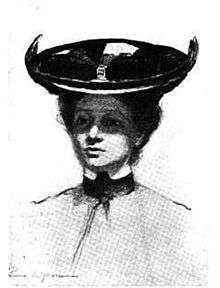Eleanor Hoyt Brainerd
Eleanor Hoyt Brainerd (January 31, 1868 – March 18, 1942) was an American author of the early 20th century. She published at least 10 novels, mostly written for young women.
Eleanor Hoyt Brainerd | |
|---|---|
 Eleanor Hoyt Brainerd, ca. 1902 | |
| Born | January 31, 1868 Iowa City, Iowa |
| Died | March 18, 1942 (aged 74) Pasadena, California |
| Pen name | Eleanor Hoyt; Eleanor Hoyt Brainerd |
| Occupation | Novelist, author, reporter, editor |
| Nationality | American |
| Alma mater | Cincinnati Wesleyan College |
| Period | 1902–1919 |
| Genre | Youth literature, novels, memoirs |
| Spouse | Charles Chisholm Brainerd |
| Relatives | Margaret Elizabeth Sangster (by marriage) |
Childhood
Eleanor was born at Plum Grove Historic House, the historic home of Robert Lucas, in Iowa City, Iowa. Her parents, Walter Hoyt and Louisa Smith were active in the abolitionist movement, Walter's family helped found the Eleutherian College. Eleanor's 1919 novel, Our Little Old Lady, is a biography of her parents.
Career

Eleanor began her professional career in New York City as a writer and editor for the New York Sun, specializing in fashion writing. Her novel In Vanity Fair drew heavily from her coverage of fashion in Paris and New York. She published extensively in magazines, including Collier's, The Girl's Own Paper, Ladies' Home Journal, The Saturday Evening Post, and Everybody's Magazine, typically in serial format. Her fictional novels often follow the same formula as the Pollyanna or Rebecca of Sunnybrook Farm series, in which a young girl, often an orphan, tries to improve the lives of adults through pluck and daring.
Three of Eleanor Hoyt Brainerd's novels were made into silent films, Pegeen (1920), How Could You Jean? (1918), and For Love of Mary Ellen (1915).[1] The most famous of these, How Could You Jean?, was directed by William Desmond Taylor and starred Mary Pickford. It was released in 1918.[2]
Personal life
Many of her novels were written in East Hampton, Connecticut, at her “Faraway Farm” retreat.[3] Eleanor married Charles Chisholm Brainerd, an attorney, in 1904. Charles was the nephew of the well-known writer Margaret Elizabeth Sangster.[4] Charles and Eleanor retired to Pasadena, California, and are buried in Oakland Cemetery, Iowa City.[5]
Published novels
- 1902 – The Misdemeanors of Nancy. Doubleday, New York. Republished in 1903 and 1904 (as Eleanor Hoyt).
- 1904 – Nancy's Country Christmas, and Other Stories. illustr. Anna Whelan Betts, Doubleday, New York.
- 1905 – Concerning Belinda. Doubleday, New York. Reprinted 1969, Books for Library Press, Freeport, New York.
- 1906 – In Vanity Fair: A Tale of Frocks and Femininity. Moffat, Yard and Co., New York.
- 1907 – Bettina. Doubleday, New York.
- 1910 – The Personal Conduct of Belinda. Doubleday, New York.
- 1912 – For Love of Mary Ellen: A Romance of Childhood. Harper, New York.
- 1915 – Pegeen. Century, New York.
- 1917 – How Could You, Jean? Doubleday, Garden City, New York.
- 1919 – Our Little Old Lady. Doubleday, Garden City, New York.
References
- Eleanor Hoyt Brainerd on IMDb
- Beauchamp, Cari, 1998, Without Lying Down: Frances Marion and the Powerful Women of Early Hollywood, University of California Press, p. 445, ISBN 0-520-21492-7.
- Des Moines Register and Leader, 1 January 1916
- Des Moines Register and Leader, 15 June 1904, p. 5.
- Iowa City Press-Citizen, 20 March 1942, p. 9; see also New York Times, 19 March 1942, p. 21.
External links
| Wikimedia Commons has media related to Eleanor Hoyt Brainerd. |